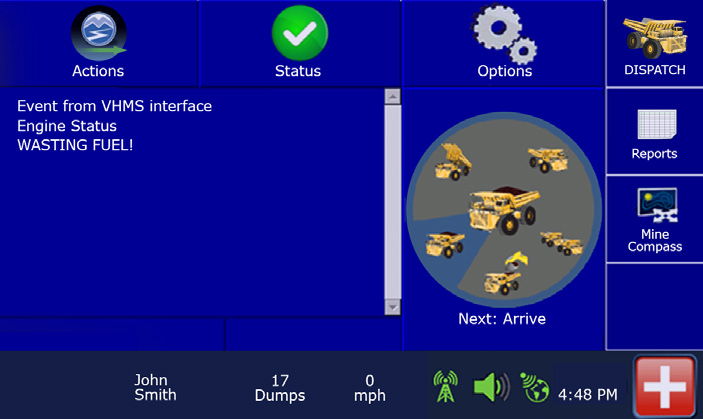Proactive Engine Idle Time Monitoring Saves Money, Environment
Fuel is one of the single largest contributors to the cost of operations at any open-pit mining operation. Rising fuel costs and the need for increased environmental sustainability highlight the urgency for more creative approaches to fuel conservation.
LOCATION
Wyoming, USA
OBJECTIVE
Identify, manage, and eliminate unnecessary idle-time events
RESULTS
Reduced engine wear and tear, improved fuel utilization, lowered CO2 emissions and noise pollution

Challenge
After observing equipment being running while immobile, the mine quickly realized that in addition to wasting fuel, the excessive idling put unnecessary wear on tear on engines and other machine parts.
Solution
Over a two-year period, Modular and mine personnel worked together to develop the DISPATCH® Fuel Saver (later renamed Idle Monitor) module. After implementation, the module quickly exhibited benefits far beyond reduced fuel consumption. Early on, the mine experienced a decrease in fuel usage, as well as marked improvements in the area of preventative maintenance.
Background
A Dispatch Manager at the mine, one of the largest and most productive coal operations in the US, observed that large equipment was often left running while stationary. Further investigation revealed that operators routinely left their equipment unmanned and idling for extended periods of time. This practice resulted in large quantities of wasted fuel and unnecessary wear and tear on engines and other components.
As a long-time user of Modular’s DISPATCH Fleet Management system, the mine turned to Modular to help them identify and manage the occurrence of idle events and reduce rising fuel costs. The result of the joint effort was the DISPATCH Idle Monitor module.
The Idle Monitor module utilizes real-time operational data acquired through the DISPATCH system’s 175+ OEM interfaces to trigger a series of alerts based on the elapsed time a machine has been running, but immobile. A combination of email messages and DISPATCH system Exception messages notify operators, dispatchers, supervisors, and mine managers that an infraction has occurred.
Configurable parameters let users determine at what intervals, and to which recipients, notifications are sent. “Each mine works differently,” said Neil Ferreira, Product Manager, Fleet Management at Modular. “To accommodate our customers’ unique needs, we build flexibility and configurability into all of our solutions.”
Methodology
The mine deployed the Idle Monitor module on more than 170 diesel-fueled trucks, dozers, scrapers, and drills; with monitoring set to take place across all shifts.
They applied a two-step notification process, in which the module alerts operators and dispatchers when idle time reaches the first specified threshold. Should the problem persist for a designated amount of time, the module sends an email to shift supervisor and managers to bring the problem to their attention and facilitate immediate investigation and corrective action.
The mine applied change management strategies to counteract initial pushback to the new policies, procedures, and operational best practices introduced during module implementation. Internal campaigns designed to explain the upsides of change and the downsides of maintaining the status quo helped increase employee adoption.

Idle-time event notification on operator’s mobile device
Results
Data collected from the module increased awareness of practices such as trucks left running during 30-minute lunch breaks, which not only wasted fuel, but also generated excessive engine hours. In response, the mine instituted a new rule: if your equipment will be left idling for more than 15 minutes, and you don’t have a very good reason for not doing so, turn it off.
After using the Idle Monitor for just under a year, the mine realized nearly $1M in annual fuel cost savings. However, over time, it became apparent that improved fuel utilization and lower fuel costs were not the only benefits realized from implementation of the Idle Monitor module.
The ability to monitor real-time engine activity and analyze reports to reveal trends allowed the mine to lengthen intervals between scheduled maintenance periods, reduce preventive maintenance part swaps, and extend the time engines remain under warranty. Because of the module, the mine was able to substantially reduce maintenance costs.
Additionally, decreased engine-idling improved air quality through lower emissions per each equipment unit monitored, while simultaneously reducing noise levels at the mine and in surrounding communities. By simply turning off equipment during lunch breaks, the mine could reduce CO2 emissions by more than 2500 metric tons.
Conclusion
The mine realized numerous quantifiable benefits following implementation of the IdleMonitor. The module was proven to not only be effective in helping the mine use less fuel, but also minimize unscheduled maintenance events, improve operational best practices, and reduce its carbon footprint.

